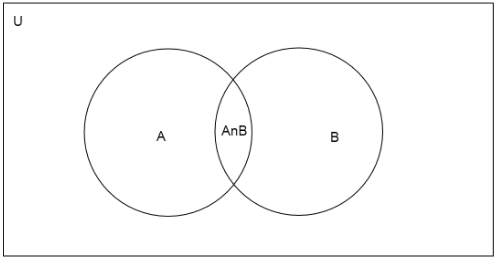Question
Question: In a class of 60 students, 40 opted for NCC, 30 opted for NSS and 20 opted for both NCC and NSS. If ...
In a class of 60 students, 40 opted for NCC, 30 opted for NSS and 20 opted for both NCC and NSS. If one of these students is selected at random, then the probability that the student selected has opted neither NCC nor for NSS is
A. 32
B. 61
C. 31
D. 65
Solution
We draw Venn diagrams for the given situation and use set theory to find the required number of students. We find the number of students who opted for either NCC or NSS by calculating union from the formula. Subtract the number of students who opted for either NCC or NSS from the total number of students to get the number of students who opted for neither NCC nor NSS. Use the formula of probability to find the required probability.
Complete step-by-step answer:
We are given that
Total number of students in class =60
U=60
Let use denote NCC by A and NSS by B
Number of students who opted for NCC =40
P(A)=40
Number of students who opted for NSS =30
P(B)=30
Number of students who opted for both NCC and NSS =20
P(A∩B)=20
Then the number of students who opted for either NCC or NSS is given by P(A∪B)
Then we can draw a Venn diagram depicting the number of students who opted for A, B and both A and B. Here U is the universal set which depicts the total number of students in class.

We use the formula P(A∪B)=P(A)+P(B)−P(A∩B) to find the value of union of A and B.
Substitute the value of P(A)=40,P(B)=30 and P(A∩B)=20 in the formula
⇒P(A∪B)=40+30−20
Add the terms in RHS
⇒P(A∪B)=70−20
Calculate the difference
⇒P(A∪B)=50
Now we have the number of students which have opted either A or B or both A and B.
Therefore, the number of students who have opted for neither A nor B is given by subtracting the number of students which have opted A or B from the total number of students in the class.
⇒Number of students who opted for neither NCC nor NSS =U−P(A∪B)
Substituting the value of U=60,P(A∪B)=50
⇒Number of students who opted for neither NCC nor NSS =60−50
⇒Number of students who opted for neither NCC nor NSS =10
Now we know Probability of an event is given by dividing the number of favorable outcomes by the total number of outcomes.
Here the number of favorable outcomes is 10 and the total number of outcomes is 60.
⇒Probability=6010
Cancel same factors from numerator and denominator
⇒Probability=61
So, the correct option is B.
Note: Students might make the mistake of assuming the union of the two elements as the total number of elements. Keep in mind union denoted the elements that are in A, B or in both A and B but we have elements that are neither in A, nor in B also. So, the universal set denotes the total number of elements available.
- If P(A)denotes the number of elements in A, P(B) denotes the number of elements in B then their intersection P(A∩B) denotes the number of elements in both A and B. Then the number of elements in A or B is given by P(A∪B). Then the formula for set theory is
P(A∪B)=P(A)+P(B)−P(A∩B) - Probability of an event is given by dividing the number of favorable outcomes by total number of outcomes.
